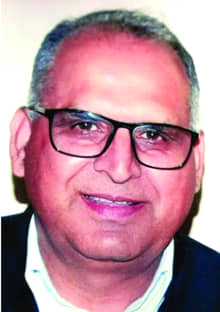Gojri Language needs to be introduced in educational institutions
*Tribal language is being ignored continuously*
Ch Rashid Azam Inqulabi

The National Education Policy 2020 has proposed various reforms in school education as well as higher education including technical education. A number of action points, activities for implementation in school education as well as higher education are suggested in the National Education Policy 2020.
The National Education Policy 2020 has ’emphasized’ on the use of the mother tongue or local language as the medium of instruction till Class 5 while, recommending its continuance till Class 8 and beyond.
Gojri is the mother tongue of a substantial segment of the population on both sides of LoC India and Pakistan, its speakers can be found in numbers in the nook and corner of the union territory of J&K. Other native languages spoken as mother tongue do have their own area of influence but very limited reach. Kashmiri for instance is spoken in the valley. Dogri, Punjabi, Mirpuri, and between the right side of river Chenab and Pir Panjal various mother tongues are modes of communication like Pogali, Hambal-Gooha, Siraji, Baderwahi, Saroodi, Bheelsavi, Padri and Kishtawari etc. Gujjari and Potwari are the only two languages spoken on both sides of Pir Panjal and LoC.
Gojri Language was included in the 6th Schedule of the J&K Constitution in 1999. Gojri should have been on the concurrent list after Kashmiri while framing the 6th schedule on merit. The demand for including it in the 8th schedule constitution of India was made by the writer, and poet of the Gojri language many times, and ultimately authorities were forced to think about the inclusion of the Gojri language in the 8th schedule of the constitution.
Our Nation is known for diversity and this diversity is all because of languages spoken here. As such we strongly project that this largely spoken language be properly documented and researched in the academic circle. This is high time for those who are at the helm of affairs to consider the introduction of the Gojri language in the curricula of Higher Educational Institutions in Jammu and Kashmir. There is a need for a Separate Department of Gojri to be created in Colleges and Universities in the interest of the preservation of this rich and historic language.
Moreover to further promote the interest in this language Serious thought is to be given towards initiating the teaching of and learning of the Gojri language at UG and PG levels as per the new Education policy 2020. Even though it is envisaged in the New Education Policy that up to primary Education teaching and learning process will be initiated in the mother tongue, the same is needs to carried to higher classes and up to the Ph.D. level as a separate subject
The new National Education Policy (NEP) recommends that all students will learn three languages in their school under the ‘formula’. At least two of the three languages should be native to India.
For example: If a student in Mumbai is learning Marathi and English, he/she will have to choose to learn another Indian language. Three-language formula, teaching/learning Hindi will be mandatory in those states where the language is not usually spoken.
The choice of languages learned will depend on the state and the students. However, it is mandatory for at least two of the three languages to be native to the country – one of which is most likely to be the local/regional language.
Although a statement issued by the Ministry of Education says that “no language will be imposed on any student. Wherever possible, the medium of instruction until at least Class 5, but preferably till Class 8 and beyond, will be the home language/mother tongue/local language/regional language .”Wherever possible” local language/mother tongue should be used. Therefore the school is likely to continue teaching in their medium of instruction and use the local language when High-quality textbooks, including in science, will be made available in home languages
In cases where home-language textbook material is not available, the language of the transaction between teachers and students will still remain the home language wherever possible. Teachers will be encouraged to use a bilingual approach, including bilingual teaching-learning materials, with those students whose home language may be different from the medium of instruction
Gojri books to be introduced in Government schools from Ist to 8th class. A good number of books are available in the Gojri language which can be taught to the students in schools and college level. Many religious books and other books were translated into Gojri by eminent writers, It was in the early seventies that AIR Srinagar, AIR Jammu, CIIL Mysore, and JK Cultural Academy played significant roles in the development of the Modern Gojri Language and literature. We at an individual level, working wholeheartedly have authored more than three dozen volumes on different aspects of the Gojri language without any official position/patronage, thus fulfilling all the requirements for its inclusion in prestigious institutions within and outside J&K. Today Gojri is spoken /understood by over 50 million people in the Sub-Himalayan Indian States as well northern parts of Pakistan & Afghanistan. Many universities have undertaken M.Phil / Ph.D. level research in Gojri including DU, JNU, IIU Islamabad, Harare University, Allama Iqbal Open University, Lahore, Punjab University Lahore, and Peshawar University. However, at the same time, it is really painful to share that Kashmir and Jammu universities have not exhibited any interest in this regard although Central University started a Certificate course in Gojri in 2015.
The matter had already been taken up with the Lieutenant Governor for introducing the Gojri Language in Universities, colleges, and school education so that Justice may be done with a regional language.
(Author is senior KAS officer (retd) Can be contacted rainqlabi @gmail.com)
